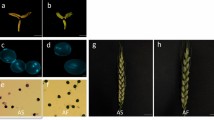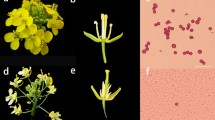Abstract
Aneuploid lilies (Lilium) could be obtained from the LAA/LAAA × AA/AAAA hybridization; however, the characteristics of their meiosis and fertility has not been reported. In this study, an aneuploid lily, J1614, was extensively investigated for its microsporogenesis, fertility and functional eggs using conventional and modern cytogenetic methods. The results indicated that J1614 was an aneuploid Longiflorum-Asiatic (LA) lily (2n = 48 = 7 L + 39 A + 2 L/A) while ‘Pearl Jason’ was an autotetraploid Asiatic lily (2n = 48 A); L-chromosomes of J1614 usually formed univalent while A-chromosomes associated not only predominantly trivalents, but also tetravalents, bivalents, and even univalent at metaphase I as well; clearly, both univalents and other associated chromosomes were separated and moved to opposite poles at anaphase I; besides, lagging chromosomes and micronuclei were observed during microsporogenesis. Hybridization showed that J1614, regardless of its male sterility, had better partial female fertility when tetraploid a lily was used as male than when a diploid as male. The nine seedlings of J1614 × AAAA were all aneuploid with variable total chromosomes ranging from 46 to 53, meaning that the functional eggs produced by J1614 contained variable chromosomes ranging from 22 to 29. Based on the present results, we concluded that once good lines are selected from aneuploid lilies, they may not only become cultivars through vegetative propagation, but also become parents to breed new aneuploids and realize introgression breeding. In addition, the mechanism of abnormal meiosis of aneuploid lilies was hypothesized.







Similar content being viewed by others
References
Ahmad F, Poerba YS, Kema GHJ, De Jong H (2021) Male meiosis and pollen morphology in diploid indonesian wild bananas and cultivars. Nucleus 64:181–191. https://doi.org/10.1007/s13237-021-00350-7
Akera T, Lampson MA (2016) Chromosome segregation: freewheeling sisters cause problems. eLife 5:e13788. https://doi.org/10.7554/eLife.13788
Ansari HA, Ellison NW, Verry IM, Williams WM (2022) Asynapsis and unreduced gamete formation in a Trifolium interspecific hybrid. BMC Plant Biol 22:1–14. https://doi.org/10.1186/s12870-021-03403-w
Barba-Gonzalez R, Lokker AC, Lim KB, Ramanna MS, Van Tuyl JM (2004) Use of 2n gametes for the production of sexual polyploids from sterile oriental × Asiatic hybrids of lilies (Lilium). Theoret Appl Genet 109(6):1125–1132. https://doi.org/10.1007/s00122-004-1739-0
Barba-Gonzalez R, Lim KB, Ramanna MS, Visser RGF, Van Tuyl JM (2005) Occurrence of 2n gametes in the F1 hybrids of oriental × Asiatic lilies (Lilium): relevance to intergenomic recombination and backcrossing. Euphytica 143(1–2):67–73. https://doi.org/10.1007/s10681-005-2657-1
Barba-Gonzalez R, Van Silfhout AA, Ramanna MS, Visser RGF, Van Tuyl JM (2006) Progenies of allotriploids of oriental × Asiatic lilies (Lilium) examined by GISH analysis. Euphytica 151:243–250. https://doi.org/10.1007/s10681-006-9148-x
Chung MY, Chung JD, Ramanna MS, Van Tuyl JM, Lim KB (2013) Production of polyploids and unreduced gametes in Lilium auratum × L. henryi hybrid. Int J Biol Sci 9:693–701. https://doi.org/10.7150/ijbs.6427
Cui L, Sun Y, Xiao K, Wan L, Zhong J, Liu Y, Zhou S (2022) Analysis on the abnormal chromosomal behaviour and the partial female fertility of allotriploid Lilium – ‘Triumphator’ (LLO) is not exceptional to the hypothesis of lily interploid hybridizations. Sci Hortic 293:110746. https://doi.org/10.1016/j.scienta.2021.110746
De Jong PC (1974) Some notes on the evolution of lilies. North Amer Lily Yearb 27:23–28
Kamstra SA, De Jong JH, Jacobsen E, Ramanna MS, Kuipers A (2004) Meiotic behaviour of individual chromosomes in allotriploid Alstroemeria hybrids. Heredity 93:15–21. https://doi.org/10.1038/sj.hdy.6800465
Khan N, Zhou S, Ramanna MS, Arens P, Herrera J, Visser RGF, Van Tuyl JM (2009) Potential for analytic breeding in allopolyploids: an illustration from longiflorum × asiatic hybrid lilies (Lilium). Euphytica 166(3):399–409. https://doi.org/10.1007/s10681-008-9824-0
Lan Y, Qu L, Xin H, Gong H, Lei J, Xi M (2018) Physical mapping of rDNA and karyotype analysis in Tulipa sinkiangensis and T. schrenkii. Sci Hortic 240:638–644. https://doi.org/10.1016/j.scienta.2018.06.055
Li X, Huang F, Chai J, Wang Q, Yu F, Huang Y, Wu J, Wang Q, Xu L, Zhang M, Deng Z (2021) Chromosome behavior during meiosis in pollen mother cells from Saccharum officinarum × Erianthus arundinaceus F1 hybrids. BMC Plant Biol 21:139–149. https://doi.org/10.1186/s12870-021-02911-z
Lim KB, Chung JD, Kronenburg BCV, Ramanna MS, De Jong JH, Van Tuyl JM (2000) Introgression of Lilium rubellum Baker chromosomes into Lilium longiflorum Thunb.: a genome painting study of the F1 hybrid, BC1 and BC2 progenies. Chromosome Res 8(2):119–125. https://doi.org/10.1023/a:1009290418889
Lim KB, Ramanna M, Jacobsen E, Van Tuyl JM (2003) Evaluation of BC2 progenies derived from 3x-2x and 3x-4x crosses of Lilium hybrids: a GISH analysis. Theor Appl Genet 106(3):568–574. https://doi.org/10.1007/s00122-002-1070-6
Liu Y, Zhang L, Sun Y, Zhou S (2021) The common occurrence of 2n eggs by lily F1 distant hybrids and its significance on lily breeding: a case of analyzing OT hybrids. Euphytica 217:203–214. https://doi.org/10.1007/s10681-021-02935-4
Liu MS, Tseng SH, Tseng TC, Chung MC (2021a) Visualizing meiotic chromosome pairing and segregation in interspecific hybrids of rice by genomic in situ hybridization. Rice Sci 28(1):69–80. https://doi.org/10.1016/j.rsci.2020.11.008
Luo J, Van Tuyl JM, Arens P, Niu L (2013) Cytogenetic studies on meiotic chromosome behaviors in sterile oriental × trumpet lily. Genet Mol Res 12(4):6673–6684. https://doi.org/10.4238/2013
Nakagawa S, FitzHarris G (2017) Intrinsically defective microtubule dynamics contribute to age-related chromosome segregation rrrors in mouse cocyte meiosis-I. Curr Biol 27(7):1040–1047. https://doi.org/10.1016/j.cub.2017.02.025
Natenapit J, Taketa S, Narumi T, Fukai S (2010) Crossing of allotriploid LLO hybrid and Asiatic lilies (Lilium). Hortic Environ Biote 51:426–430
Ramanna MS, Jacobsen E (2003) Relevance of sexual polyploidization for crop improvement--A review. Euphytica 133:3–18. https://doi.org/10.1023/A:1025600824483
Silkova OG, Adonina IG, Krivosheina EA, Shchapova AI, Shumny VK (2013) Chromosome pairing in meiosis of partially fertile wheat/rye hybrids. Plant Reprod 26(1):33–41. https://doi.org/10.1007/s00497-012-0207-2
Suzuki T, Yamagish M (2015) Aneuploids without bulbils segregated in F1 hybrids derived from triploid Lilium lancifolium and diploid L. leichtlinii crosses. Hortic J 85:224–231. https://doi.org/10.2503/hortj.MI-089
Van Tuyl JM, Arens P (2011) Lilium: breeding history of the modern cultivar assortment. Acta Hort 900(27):223–230. https://doi.org/10.17660/actahortic.2011.900.27
Van Tuyl JM, Van Dijken A, Chi HS, Lim KB, Villemoes S, Van Kronenburg BCE (2000) Breakthroughs in interspecific hybridization of lily. Acta Hort 508(10):83–90. https://doi.org/10.17660/actahortic.2000.508.10
Wang Q, Wang J, Zhang Y, Zhang Y, Xu S, Lu Y (2015) The application of fluorescence in situ hybridization in different ploidy levels cross-breeding of lily. PLoS ONE 10:e0126899. https://doi.org/10.1371/journal.pone.0126899
Wang J, You H, Tian J, Wang Y, Liu M, Duan W (2015a) Abnormal meiotic chromosome behavior and gametic variation induced by intersectional hybridization in Populus L. Tree Genet Genomes 11(3):61–72. https://doi.org/10.1007/s11295-015-0880-z
Wu L, Wan L, Cui L, Xiao K, Zhong J, Liu Y, Zeng J, Sun, Zhou S (2021) Analysis of the cross-compatibility of Lilium brownii var. viridulum and L. davidii var. unicolor. Scientia Horticulturae https://doi.org/10.1016/j.scienta.2021.110130
Xi M, Van Tuyl JM, Arens P (2015) GISH analyzed progenies generated from allotriploid lilies as female parent. Sci Hortic 183:130–135. https://doi.org/10.1016/j.scienta.2014.12.022
Xiao K, Zheng W, Zeng J, Wu L, Cui L, Liu Y, Yang Y, Zhou S (2019) Analysis of abnormal meiosis and progenies of an odd-allotetraploid. Lilium ‘Honesty’ Sci Hortic 253:316–321. https://doi.org/10.1016/j.scienta.2019.04.012
Xiao K, Zhu Z, Zou N, Zhang L, Sun Y, Zhou S (2022) The characteristics of abnormal meiosis and functional aneuploid pollen of odd-allotetraploid lily ‘Honesty’ unveiled using in situ hybridization. Sci Hortic. https://doi.org/10.1016/j.scienta.2022.111091
Xie S, Ramanna MS, Van Tuyl JM (2010) Simultaneous identification of three different genomes in Lilium hybrids through multicolour GISH. Acta Hortic 855:299–304. https://doi.org/10.17660/ActaHortic.2010.855.45
Xie S, Ramanna MS, Visser RGF, Van Tuyl JM (2013) Elucidation of intergenomic recombination and chromosome translocation: meiotic evidence from interspecific hybrids of Lilium through GISH analysis. Euphytica 194:361–370. https://doi.org/10.1007/s10681-013-0943-x
Zhang X, Ren G, Li K, Zhou G, Zhou S (2012) Genomic variation of new cultivars selected from distant hybridization in Lilium. Plant Breed 131(1):227–230. https://doi.org/10.1111/j.1439-0523.2011.01906.x
Zhang Q, Cao Q, Zhou P, Jia G (2017) Meiotic chromosome behavior of the male-fertile allotriploid lily cultivar ‘Cocossa’. Plant Cell Rep 36(10):1641–1653. https://doi.org/10.1007/s00299-017-2180-6
Zhong J, Cai J, Liu S, Wang Z, Yin D, Zhou S (2022) GISH analysis of introgressive hybridization using aneuploids as male parents in Lilium. Euphytica 218(11):167–174. https://doi.org/10.1007/s10681-022-03116-7
Zhou S (2007) Intergenomic recombination and introgression breeding in Longiflorum × Asiatic lilies. PhD thesis, Wageningen University, The Netherlands
Zhou S (2011) -12) The potential of aneuploids for selecting new lily cultivars. North Amer Lily Yearb 63: 100–105
Zhou S (2014) Aneuploidy in lily breeding. Acta Hort 1027:149–153. https://doi.org/10.17660/ActaHortic.2014.1027.15
Zhou S, Ramanna MS, Visser RGF, Van Tuyl JM (2008) Analysis of the meiosis in the F1 hybrids of longiflorum × asiatic (LA) of lilies (Lilium) using genomic in situ hybridization. J Genet Genomics 35:687–695. https://doi.org/10.1016/S1673-8527(08)60091-0
Zhou S, Li K, Zhou G (2011) Euploid endosperm of triploid × diploid/tetraploid crosses results in aneuploid embryo survival in Lilium. HortScience 46:558–562. https://doi.org/10.21273/HORTSCI.46.4.558
Zhou S, Li K, Zhou G (2012) Analysis of endosperm development of allotriploid × diploid/tetraploid crosses in Lilium. Euphytica 184:401–412. https://doi.org/10.1007/s10681-011-0609-5
Zhou S, Tan X, Fang L, Jian J, Xu P, Yuan G (2013) Study of the female fertility of an odd-tetraploid of Lilium and its potential breeding significance. J Am Soc Hortic Sci 138(2):114–119. https://doi.org/10.21273/JASHS.138.2.114
Zhou S, Yuan G, Xu P, Gong H (2014) Study on lily introgression breeding using allotriploids as maternal parents in interploid hybridizations. Breed Sci 64:97–102. https://doi.org/10.1270/jsbbs.64.97
Zhou S, Zhong L, Zhang L, Xu Z, Liu X, Li K, Zhou G (2015) Study on the homology of the genomes of tetraploid Asiatic lilies (Lilium) using FISH. Genome 11:453–461. https://doi.org/10.1139/gen-2015-0057
Zielinska AP, Holubcova Z, Blayney M, Elder K, Schuh M (2015) Sister kinetochore splitting and precocious disintegration of bivalents could explain the maternal age effect. eLife 4:e11389. https://doi.org/10.7554/eLife.11389
Acknowledgements
This work was supported by the National Natural Science Foundation of China for financial supports (No. 32260783 and 31572154).
Funding
The funding was provided by National Natural Science Foundation of China (Grant Nos. 32260783 and 31572154)
Author information
Authors and Affiliations
Contributions
KX did experiments, prepared an initial manuscript on materials, methods, and results. YS was responsible for managing some experimental materials and for correcting reference list. SZ proposed the main ideas, wrote the introduction and discussion, and corrected the whole manuscript several times. All authors reviewed the manuscript.
Corresponding author
Ethics declarations
Conflict of interest
The authors declare no competing interests.
Additional information
Publisher’s Note
Springer Nature remains neutral with regard to jurisdictional claims in published maps and institutional affiliations.
Rights and permissions
Springer Nature or its licensor (e.g. a society or other partner) holds exclusive rights to this article under a publishing agreement with the author(s) or other rightsholder(s); author self-archiving of the accepted manuscript version of this article is solely governed by the terms of such publishing agreement and applicable law.
About this article
Cite this article
Xiao, K., Sun, Y. & Zhou, S. Revealing the abnormal meiosis and the variation of the functional female gametes of aneuploid lily (Lilium) using genomic in situ hybridization (GISH). Euphytica 219, 108 (2023). https://doi.org/10.1007/s10681-023-03238-6
Received:
Accepted:
Published:
DOI: https://doi.org/10.1007/s10681-023-03238-6




